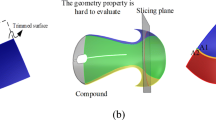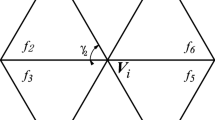Abstract
As a representation of free-form surface, triangle mesh model (commonly with the stereo lithography format) has gained wide application in CAD and CAM recently because of its simple geometric computation, superior robustness, and high efficiency in tool path generation. However, conventional tool-path generation methods for NURBS surface are incapable of direct application to mesh models. Development of a tool-path generation method based on mesh model with high machining precision is becoming a key problem for NC machining. In this paper, a spiral tool-path generation method in finish-cut process is developed based on the offset-surface method (also called cutter location method). A novel local subdivision method is proposed firstly to guarantee edges of the offset-mesh within the required tool-path interval, and then gouge-free tool-path is generated by organizing path through vertex of the offset-mesh. Therefore, all the path intervals are under precise control by the local subdivision, allowing the mesh surface with both steeper and flatter areas to be machined with high-precision. Besides, tool-path naturally runs along the boundary of the triangle mesh model, ensuring continuous cut for reducing the fluctuation of cutting load. At last, tool-paths with multiple connective areas are generated for several complex mesh surfaces to clarify efficiency and robust of proposed method.
Similar content being viewed by others
References
Derose T, Kass M, Truong T (1998) Subdivision surfaces in character animation. In: SIGGRAPH 98 Conference Proceedings, Annual Conference Series, 85–94
Wu P, Suzuki H, Kaze K (2005) Three-axis NC cutter path generation for subdivision with z-map. JSME Int J Ser C 48(4)
Park SC, Chang M (2010) Tool path generation for a surface model with defects. Comput Ind 61:75–82
Li L, Schemenauer N, Peng X, Zeng Y, Gu P (2002) A reverse engineering system for rapid manufacturing of complex objects. Robot Comput Integr Manuf 18:53–67
Sun YW, Guo DM, Jia ZY, Wang HX (2006) Iso-parametric tool path generation from triangular meshes for free-form surface machining. Int J Adv Manuf Technol 28:721–726
Sugita N, Nakano T, Kato T, Nakajima Y (2010) Tool path generation for bone machining in minimally invasive orthopedic surgery. IEEE/ASME Trans Mechatron 15(3)
Lai YL (2010) Tool-path generation of planar NURBS curves. Robot Comput Integr Manuf 26:471–482
Kim BH, Choi BK (2000) Guide surface based tool path generation in 3-axis milling: an extension of the guide plane method. Comput Aided Des 32:191–199
Hwang JS (1992) Interference-free tool-path generation in the NC machining of parametric compound surface. Comput Aided Des 24(12):667–676
Saito T, Takahasi T (1991) NC machining with G-buffer method. Proceedings of the 18th annual conference on Computer graphics and interactive techniques 25(4):207–216
Kim SJ, Yang MY (2006) A CL surface deformation approach for constant scallop height tool path generation from triangular mesh. Int J Adv Manuf Technol 28:314–320
Zhang ZX, Savchenko M, Hagiwara I, Ren B (2010) 3-axis NC tool path generation and machining simulation for subdivision surface of complex models. Int J CAD/CAM 10(1):1–9
Shan Y, Wang SL, Tong SG (2000) Uneven offset method of NC tool path generation for free-form pocket machining. Comput Ind 43:97–103
Lee E (2003) Contour offset approach to spiral tool-path generation with constant scallop height. Comput Aided Des 35:511–518
Kim HC (2010) Optimum tool path generation for 2.5D direction-parallel milling with incomplete mesh model. J Mech Sci Technol 24(5):1019–1027
Kim HC (2010) Tool path generation for contour parallel milling with incomplete mesh model. Int J Adv Manuf Technol 48:443–454
Jun CS, Kim DS, Park SY (2002) A new curve-based approach to polyhedral machining. Comput Aided Des 34:379–389
Dai J, Wang H, Qin K (2004) Parallel generation of NC tool paths for subdivision surfaces. Int J CAD/CAM 4(1)
Xu R, Chen Z, Chen W, Zhu J (2010) Dual drive cue tool path planning method for 5-axis NC machining of sculptured surface. Chin J Aeronaut 23:486–494
Lee CS, Lee JH (2010) Geometric modeling and tool path generation of model propellers with a single setup change. Int J Adv Manuf Technol 50:253–263
Lee SG, Kim HC, Yang MY (2008) Mesh-based tool path generation for constant scallop-height machining. Int J Adv Manuf Technol 37:15–22
Narutaki N, Yamane Y, Hayashi K, Kitagawa T (1997) High-speed machining of in conel 717 with ceramic tools. Ann CIRP 46(1):57–62
Loop CT (1987) Smooth subdivision surface based on triangles. M.S. Thesis, Department of Mathematics, University of Utah
DeRose T, Kass M, Truong T (1998) Subdivision surfaces in character animation. Proceedings of the 25th annual conference on Computer graphics and interactive techniques 194–203
Zorin D, Schroder P (2000) Subdivision for Modeling and Animation. SIGGRAPH 2000 Course Notes ACM SIGGRAPH
Desbrun M, Meyer M, Schroder P, Barr AH (1999) Implicit fairing of irregular meshes using diffusion and curvature flow. Computer Graphics Proceedings, Annual Conference Series, ACM SIGGRAPH, Los Angeles, California, 317–324
Author information
Authors and Affiliations
Corresponding author
Rights and permissions
About this article
Cite this article
Zhang, Z., Feng, Y., Ren, B. et al. Exploratory study of spiral NC tool path generation on triangular mesh based on local subdivision. Int J Adv Manuf Technol 83, 835–845 (2016). https://doi.org/10.1007/s00170-015-7640-y
Received:
Accepted:
Published:
Issue Date:
DOI: https://doi.org/10.1007/s00170-015-7640-y




